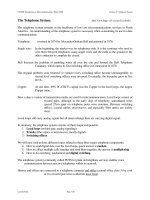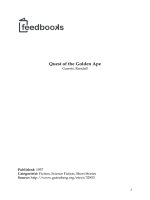Exploring the Solar System potx
Bạn đang xem bản rút gọn của tài liệu. Xem và tải ngay bản đầy đủ của tài liệu tại đây (17.79 MB, 178 trang )
Contributed by:
MEMONZ MIND
A History with 22 Activities
MARY KAY CARSON
Exploring the Solar System
REVISED EDITION
To future explorers
PHOTO CREDITS
Pages vi, 10 and back cover, 16 courtesy of Tom Uhlman
Pages 3, PIA00157; 45, P288A; 45, PIA02975; 59, PIA04594; 62, PIA01522;
65, PIA02999; 66, PIA03153; 69, PIA00572; 70, PIA00145; 71, PIA00407;
77, PioneerFlyby; 80, PIA04495; 88, PIA01490; 90, P24652B; 93, JPL-
28311; 103, PIA01193; 104, PIA00744; 105, PIA00200; 108, PIA01466;
112, PIA03142; 113, PIA04604; 119, PIA04421; 121, Joy_Crisp_040831;
122, PIA06837; 126, PIA05275; 133, PIA02410; 131; 136, PIA04892; 136,
PIA05488; 142, PIA00157; 159, PIA00119 courtesy of the National Aero-
nautics and Space Administration (NASA) Jet Propulsion Laboratory (JPL)
Pages 7, LC-USZ62-21237; 12, LC-USZ62-7923 courtesy of the Library of
Congress, Prints & Photographs Division
Pages 18, Goddard-1926; 25, 74-H-1210; 28, Korolev1954; 30, sputnik1;
31, sputnik2; 32, VAN-9; 38, AS11-40-5903; 41, cosmonauts1960; 42,
gagarin01; 42, yurigagarin01; 43, S88-31378; 46, 67-H-218; 49, 68-HC-
870; 56, voskhod1965; 67, 74-H-856; 90, 72-H-192; 96, STS061-98-050
courtesy of NASA Headquarters
Pages 20, MSFC-8007271; 21, MSFC-9138034; 21, MSFC-9248163; 26, MSFC-
9906009; 27, MSFC-9131496; 32, MSFC-5700940; 33, MSFC-5800669; 34,
MSFC-5800537; 34, MSFC-0200146; 35, MSFC-0100074; 35, MSFC-5663627;
37, MSFC-5900120; 42, MSFC-9248173; 50, MSFC-0101140; 51, MSFC-
6901046; 75, MSFC-8915499; 98, MSFC-8663390; 135, MSFC-9249473;
134, MSFC-0201903; 134, MSFC-0201791 courtesy of NASA Marshall Space
Flight Center
Page 24 courtesy of the United States Patent and Trademark Office, U.S.
Patent # 1,102,653
Pages 24, G-32-04; 138, 091; 143, GL-2002-001476; 144, GL-2002-002528;
157, GL-2002-001140 courtesy of NASA Goddard Space Flight Center
Pages 30, 113, 132 courtesy of NASA
Page 31 courtesy of Wolfgang Hausmann
Pages 36, 59-008A-01A; 60, 64-0771-01A; 64, 75-050D-01A; 71, 75-075A-
01F; 72, 75-083C-06F(P-17686); 72, 75-083C-06F(P-21873); 74, 73-085A-
01S; 85, 77-084A-01A; 145, 69-059A-01A; 148, 75-075A-01F courtesy of
National Space Science Data Center (NSSDC)
Pages 39, 61C-0189; 40, 84PC-0022; 48, BurntCapsule; 67, KSC-74PC-0303;
101, 89PC-0732; 107, 96PC-1130; 134, KSC-01PP-1087; 134, KSC-69PC-
0435; 153, KSC-97PC-0610; 158, KSC-97PC-0558 courtesy of NASA Kennedy
Space Center
Library of Congress Cataloging-in-Publication Data
Carson, Mary Kay.
Exploring the solar system for kids : a history with 22 activities/
Mary Kay Carson.—Revised ed.
p. cm.
Includes bibliographical references and index.
ISBN-13: 978-1-55652-715-9
ISBN-10: 1-55652-715-2
1. Outer space—Exploration—Juvenile literature. 2. Astronomy
—Study and teaching—Activity programs—Juvenile literature.
I. Title.
QB500.262.C37 2006
523.2—dc22
2005028284
© 2006, 2008 by Mary Kay Carson
All rights reserved
Revised edition
Published by Chicago Review Press, Incorporated
814 North Franklin Street
Chicago, Illinois 60610
ISBN-13: 978-1-55652-715-9
ISBN-10: 1-55652-715-2
Printed in Italy
5 4 3 2 1
Cover and interior design: Joan Sommers Design
Interior illustrations: TJ Romero
Pages 46; 65, P-12035A; 92, LSPN-1725 courtesy of NASA and NSSDC
Pages 52, S69-31739; 53, AS11-40-5873; 54 and back cover, AS17-147-
22526; 55, AS17-145-22157; 55, S73-15713; 57, AS17-134-20530 courtesy
of NASA Johnson Space Center
Page 58 courtesy of Arne Koertzinger
Pages 68, AC76-0564; 78, AC73-9253; 78, 79-H-732; 82, AC77-0850; 89,
AC97-0036-1 courtesy of NASA Ames Research Center
Page 72 courtesy of Michael Okoniewski
Pages 76, 94 courtesy of European Space Agency (ESA)
Page 79 courtesy of the Lunar and Planetary Laboratory, University of Arizona
Pages 83, PIA00343; 84, PIA00400; 86, PIA00032; 88, PIA00340; 109; 110,
PIA03883; 112, PIA03143; 114; 117, PIA06992; 124, 125; 127; 139,
PIA03101; 141, PIA00104; 154, PIA00032; 155, PIA01492; 160, PIA05569
courtesy of NASA/JPL-Caltech
Page 99 courtesy of the Space Telescope Science Institute (STScI), R. Evans,
J. Trauger, H. Hammel and the HST Comet Science Team, and NASA
Page 100 courtesy of the Space Telescope Science Institute (STScI) and NASA
Page 116, PIA06425 courtesy of NASA/JPL/GSFC/Ames
Page 117 courtesy of ESA/NASA/University of Arizona
Pages 120, PIA05755; 120, PIA05634; 123, PIA05591 courtesy of
NASA/JPL/Cornell
Page 128 courtesy of Johns Hopkins University Applied Physics
Laboratory/Southwest Research Institute
Page 130, STSCI-PR94-17/MRPS87787 courtesy of Dr. R. Albrecht, ESA/ESO
Space Telescope European Coordinating Facility, and NASA
Page 130, STSCI-PRC96-09A/MRPS87785 courtesy of Alan Stern (Southwest
Research Institute), Marc Buie (Lowell Observatory), NASA, and ESA
Page 131 courtesy of NASA, ESA, and G. Bacon (STScI)
Pages 133, 135 courtesy of NASA/Johns Hopkins University Applied Physics
Laboratory/Carnegie Institution of Washington
Page 146 courtesy of National Space Science Data Center, NASA Goddard
Space Flight Center
Page 154, PIA02963 courtesy of Kenneth Seidelmann, U.S. Naval
Observatory, and NASA
Page 156 courtesy of NASA/Southwest Research Institute
This book wouldn’t have happened without the enthusiasm and support of editor and fellow
space buff Jerome Pohlen—thanks, Jerry! Photographer Tom Uhlman deserves many thanks for
contributing his always-amazing photographs. Thanks also to the Lunar and Planetary Laboratory
at the University of Arizona for graciously supplying the photograph of Gerard Kuiper.
Acknowledgments
iii
Today we know a lot about the planets, moons,
comets, and asteroids of our solar system. But
while humans have walked on the Moon, we’ve
never set foot on any other planet. So how do
we know that Mars is covered in rusty dust and
that yellow clouds float over Venus? How did
we take the temperature of the Sun and figure
out what’s inside comets? That’s what this
book is all about. It tells the story of how we
discovered and learned what we know about
our solar system.
Starting on page 137 is a “Field Guide to the
Solar System.” This reference section features
basic facts about the planets and their moons,
the Sun, dwarf planets, comets, and asteroids,
and time lines detailing our exploration of them.
Astronomers and space scientists are making
new discoveries about the solar system all the
time. At this moment space missions and astro-
nomical observatories are further exploring the
planets, moons, dwarf planets, comets, and
asteroids of our solar system. While this book is
as up-to-date as possible, new findings emerge
every day. The Web sites found on page 164 and
within the Exploration Time Lines in the “Field
Guide to the Solar System” can update you on
future discoveries and help you to continue
learning. Keep exploring!
Note to Readers
Prehistory–1900:
Spying on the Heavens
1
Spy the Evening Star 3
Outlining Orbits 6
Build a Telescope 11
CD Spectroscope 17
1
1900–1950s:
Rocketing to Space
19
Blast Off a Rocket 23
Walk to Pluto 27
Go Satellite Watching 33
2
1960s: Racing to the Moon—and Beyond 39
Map the Moon’s Surface 44
Work Like an Astronaut 56
Create Kitchen Craters 59
3
1970s: Probing the Planets 63
Planetary Warm-Up 66
Is It Organic? 69
Parachuting Eggs 73
4
Note to Readers and Acknowledgments iii
Time Line vi
1980s: Voyage to the
Outer Planets
81
Know the Code! 87
Greetings from Earth 90
Kitchen Comet Nucleus 95
5
Contents
1990s: A Telescope in Space
and a Rover on Mars
97
Metric Matters 106
6
2010s: Going to Extremes 129
My Mars Mission 132
Make a Mission Patch 134
8
Field Guide to the Solar System 137
Glossary 161
Resources 164
Web Sites to Explore 164
Books to Read 165
Index 166
2000s: Near-Earth Objects, Saturn’s
Rings, and Martian Seas
111
Catch and Count Falling Stars 115
Put Together a Probe 118
See Mars in 3-D 126
7
vi
Prehistory Humans mark the passage of time with
lunar phases and observe Mercury, Venus,
Mars, Jupiter, and Saturn with the naked eye
Ancient Times Chinese, Babylonians, Greeks, and
Egyptians record their observations of the
night sky
A.D.140 Ptolemy writes that Earth is the center of
the cosmos
1543 Copernicus states that the Sun is the center
of the cosmos
1609 Galileo Galilei builds the first astronomical
telescope and begins observations
1616 Johannes Kepler publishes his third law of
planetary motion
1668 Isaac Newton builds the first reflecting
telescope after defining the laws of gravity
1758 Halley’s comet appears, just as Edmond Halley
had predicted 53 years earlier
1781 William Herschel discovers Uranus
1801 Giuseppe Piazzi discovers Ceres
Time Line
1846 Johann Galle discovers Neptune
1926 Robert Goddard launches the world’s first
liquid-fueled rocket
1930 Clyde Tombaugh discovers Pluto
1944 Wernher von Braun’s V-2 rockets begin
falling on England
1957 World’s first satellite, Sputnik 1, orbits Earth
1958 NASA is formed and launches its first
spacecraft, Pioneer 1
1959 Luna 2 is the first spacecraft to impact
the Moon
Luna 3 returns the first photographs of
the Moon’s far side
1961 Yuri Gagarin, aboard Vostok 1, is the first
human in space and in Earth’s orbit
1962 Mariner 2 to Venus is the first successful
space probe to another planet
1964 Ranger 7 is the first space probe to send
back close-ups of the Moon
1965 Mariner 4 is the first spacecraft to success-
fully fly by Mars
1966 Luna 9 is the first space probe to “soft
land” on the Moon and photogrpah its
surface
1967 Venera 4 to Venus is the first atmospheric
space probe
1968 Zond 5 is the first spacecraft to fly around
the Moon and return to Earth
1969 Apollo 11 delivers the first humans to the
Moon
vii
1977 James Elliot discovers Uranus’s rings
1979 Pioneer 11 is the first space probe to
visit Saturn
1983 Venera 15 is the first radar mapping probe
to Venus
1986 Vega 1, Vega 2, Sakigake, Suisei, and Giotto
make flybys of Halley’s comet
Voyager 2 is the first spacecraft to visit Uranus
1990 Hubble Space Telescope is the first orbiting
telescope
1991 Galileo is the first space probe to fly by an
asteroid, Gaspra
1994 Hubble Space Telescope creates the first maps
of Pluto and photographs the comet
Shoemaker-Levy 9’s impact with Jupiter
1995 Galileo is the first spacecraft to orbit Jupiter
and releases the first atmospheric probe to
Jupiter
1997 Comet Hale-Bopp is visible to the naked eye
Mars Pathfinder delivers the first rover,
Sojourner, to Mars
2001 NEAR Shoemaker to Eros is the first spacecraft
to orbit and land on an asteroid
2004 Cassini is the first orbiter of Saturn
2005 Huygens sets down on Titan, the first probe to
land in the outer solar system
Mike Brown discovers Eris
2006 First spacecraft to visit Pluto, New Horizons,
launches
1970 Venera 7 to Venus is the first spacecraft to
successfully land on another planet
Luna 16 is the first sample-return mission,
bringing soil samples from the Moon’s surface
back to Earth
Luna 17 delivers the first robotic rover,
Lunokhod 1, to the Moon
1971 Mariner 9, in its journey to Mars, is the first
planetary orbiter
1973 Pioneer 10 is the first spacecraft to pass
through the asteroid belt and the first to
visit Jupiter
1974 Mariner 10 is the first spacecraft to use
gravity assist and the first to fly by Mercury
1975 Venera 9 is the first Venus orbiter and the
first lander to send photos from the surface
of another planet
1976 Viking 1 and Viking 2 are the first soft landers
on Mars
he next time you’re outside on a clear night, look up.
You won’t be the first person to marvel at the Moon
and stars. Studying the lights in the night sky is
something that humans have always done. People
have used recognizable star patterns, called constellations,
to mark the passing of time for thousands of years. Ancient
peoples used star calendars to help time crop plantings and
to move to new hunting grounds as the seasons changed.
The night sky’s pattern of stars, or starscape, is like a
background of lights out in space. Our view of the starscape
shifts during the year as the Earth travels around the Sun. The
Big Dipper, for example, appears handle up in the sky during
the summer and handle down during the winter. But the Big
Dipper always keeps its ladle shape because it’s not the stars,
but Earth, that is moving. This changing view allows us to use
the constellations as a kind of calendar.
If you counted all the stars you could see while looking up
at the night sky, you’d get to about 3,000 before running out
of bright dots. But you would have miscounted by a few. That’s
because some of the very brightest dots aren’t actually stars.
The ones that shine without twinkling are really planets.
Depending on when you look and how much city light is
around, you can see the planets Mercury, Venus, Mars,
Jupiter, and Saturn with just your eyes.
WONDERING ABOUT WANDERERS
In ancient times the Chinese, Babylonians, Greeks, and
Egyptians recorded their observations of stars. They noticed
that five “stars” were different from the thousands of others—
they didn’t twinkle. They also noted that these brightly
shining “stars” seemed to move differently, too. On most
nights, these five “wandering stars” travel from east to west.
But they show up in different places on the starscape from
one night to the next. And their speed and direction change,
too. Sometimes they move quickly, but other times slowly—
or even stop, then go backward! The odd movements of
the “wandering stars” seemed purposeful, or intelligent,
to some ancient cultures. Many believed that the wanderers
were gods moving back and forth as they went about their
heavenly business.
Prehistory1900:
Spying on the Heavens
The bright evening
star near the Moon
isn’t a star at all.
It’s the planet Venus.
T
1
1
The five “wandering stars” are, of course, not
stars at all. They’re the planets Mercury, Venus,
Mars, Jupiter, and Saturn. They seem to “wander”
across the night sky because, unlike stars, planets
really do move. Planets don’t twinkle like stars
because planets are so much closer to us. The
strong, steady light of the nearby Sun reflects
off a planet’s entire lit side, causing it to shine
a beam of light toward Earth. By comparison,
from Earth faraway stars look like single points
of light. Those tiny points of weak starlight get
bounced and blurred coming through Earth’s
atmosphere. That’s what causes stars to twinkle.
The nearest planet, Venus, is 67 million
miles (108 million km) from Earth. That seems
far, but not compared to the nearest star, Alpha
Centauri. It’s 25 trillion miles (40 trillion km)
away! That’s the difference between walking a
single step and hiking across the state of
Indiana! These five planets are not a part of the
unchanging starscape background. They’re part
of our solar system.
Everything in the solar system—planets and
their moons, dwarf planets, asteroids, and
comets—travels around the Sun. But each planet
2
Prehistory–1900: Spying on the Heavens
The planets can appear to slow down, stop, and change direction against the background of the
unchanging starscape. This is because the closer the planets are to the Sun, the speedier their orbit.
This diagram shows how Mars looks like it’s moving backward each time the faster-moving Earth
passes it up. The looping path on the right shows how Mars’s travels look from Earth.
Why They Wander
revolves, or orbits, around the Sun at its own
uneven pace—all while the Earth is doing the
same. Looking at moving planets from a world
that is also on the go makes for some odd tricks
of perspective. It’s like watching a truck as you’re
passing it on the highway. The truck can look like
it’s standing still or even slipping backward, but
it isn’t really. Your car is just moving faster and
passing it by (see “Why They Wander,” page 2).
Sometime around the sixth century
B.C.,
ancient Greek scholars decided that the five
“wandering stars” were not really gods who were
out for heavenly strolls. The scholars began to
carefully chart the paths of the planets, create
tables of measurements, and work on ideas that
would explain the planets’ movements. They
were some of the world’s first astronomers.
FINDING THE COSMOS’S CENTER
By the second century, ancient scholars had
come up with an explanation of how the planets
moved that didn’t involve gods. It was hammered
out by a Greek astronomer, mathematician, and
geographer working in the great Egyptian city of
Alexandria. His name was Ptolemy (TALL-uh-me).
Spy the Evening Star
There are five planets visible to the naked eye. But Venus is by far the easiest to see.
Often called the “Evening Star,” Venus is the third-brightest object in Earth’s sky,
after the Sun and the Moon. Look for
Venus around sunrise or sunset,
not in the middle of the night.
It will appear close to the
horizon near the Sun.
(Remember, never look
directly at the Sun!)
When and where Venus
appears in the sky
depends on where it is in
its orbit around the Sun.
Check a night-sky calendar
in a magazine about astro-
nomy or telescopes, in the
weather section of many news-
papers, or on a sky calendar Web site
(see page 165).
If you have a pair of seven-power (7x) or stronger binoculars you can see Venus
change shape over time. You can even track the shapes Venus goes through (called
phases) and prove that Venus orbits the Sun—just like Galileo did. Just sketch Venus’s
shape night after night and see how it changes phases. Hope for clear weather!
3
But Copernicus decided that Ptolemy’s system
was too ridiculously complicated to be true.
He decided that the simplest way to explain how
the cosmos moved was to put the Sun in the
center, with all of the planets, including Earth,
revolving around it. He thought the Earth must
spin itself around once every day. Copernicus
According to his theory of the universe, Earth
is a sphere that never spins or moves. Instead,
it is fixed in the center of the cosmos, and all
the other planets and the Sun orbit around it.
Ptolemy explained the wandering paths of the
planets by claiming that these planets moved
around in their own mini-orbits within different
layers of celestial stuff. Ptolemy’s theory may
not sound that convincing today, but it was
then. If you accept the Ptolemaic system of
circles and spheres as true, the system can be
used to predict the paths of the planets across
the night sky pretty well. Maybe this explains
why the Ptolemaic system was widely accepted
in both Europe and the Middle East for more
than a thousand years!
It took a Polish clergyman to finally change
people’s ideas about the center of the cosmos.
Nicolaus Copernicus (Coh-PER-nih-cus) was born
Mikolaj Kopernik in 1473. After studying law
and medicine in Italy, Copernicus took up math
and astronomy. Then he moved back to Poland,
became a church official, and started studying
the night sky. Most astronomers during the 1500s
worked on fine-tuning the Ptolemaic system.
4
Prehistory–1900: Spying on the Heavens
This 16th-century engraving illustrates the
universe according to Ptolemy. The watery Earth is
in the center with the Moon and the Sun circling
around it, and the zodiac constellations lay beyond.
Nicolaus Copernicus put the Sun in its proper
place—the center of the solar system.
Finding the Cosmos’s Center
5
wrote up his ideas in a book called On the
Revolutions of the Heavenly Spheres.
It’s unlikely that Copernicus knew that his
ideas would soon start the age of modern astro-
nomy. But he did know that saying the Sun was
the center of the cosmos could get him into
trouble. Copernicus was an official of the church,
after all. And the church stated that the Earth
was the most important thing in the cosmos—
that it was unlike any other planet and that it
rightfully belonged in the center of the universe.
That’s why Copernicus put off publishing his
book until he was dying. He died in bed after
seeing the first copy of it on May 24, 1543.
Copernicus’s Sun-centered, or heliocentric,
view of the cosmos helped bring about the
scientific Renaissance. By 1600 most astronomers
accepted that the Sun was the center of the
cosmos, that all the planets circled around it,
and that the Earth spun around, creating day
and night. But Copernicus’s theory had a big
problem. It didn’t actually predict the path of
the planets very well. Why didn’t Copernicus’s
cosmic model match what astronomers were
seeing in the night sky? It was a question that
Johannes Kepler learned
about, and embraced,
Copernicus’s heliocentric
theory in college. He
later taught math and
astronomy, and then
became an assistant to
Tycho Brahe. Kepler’s
discovery that the planets
move in elliptical orbits
led to Kepler’s laws of planetary motion:
Law 1: All the planets follow an elliptical
orbit around the Sun.
Law 2: The planets move faster when they
are passing closer to the Sun.
Law 3: Each planet’s orbit time is related
mathematically to its distance from the Sun.
(This means that you can calculate how far
away a planet is from the Sun if you know
how long it takes the planet to make one
orbit around it.)
Kepler wrote the following epitaph for him-
self: “I used to measure the heavens, now I
shall measure the shadows of the earth.
Although my soul was from heaven, the
shadow of my body lies here.”
Johannes Kepler (1571–1630)
pestered Johannes Kepler for many years. Kepler
was the German-born assistant of Tycho Brahe
(BRA-hey), the greatest observer of the planets
at the time (this was before Galileo and the
invention of the telescope). For many years
Brahe made detailed records of where each planet
was in its night-by-night path through the dark
sky. After Brahe died, Kepler replaced him as the
astronomer at an observatory in Prague.
Kepler knew firsthand that Brahe’s observa-
tions were absolutely accurate. So why didn’t
they match Copernicus’s theory of how the
planets should move across the sky? Kepler
decided to study the problem by concentrating
on the movement of just one planet—Mars.
Kepler had Brahe’s detailed records of Mars’s
movements—and he knew they were right. For
six years, with failing eyesight, Kepler tried com-
binations of circular orbits that would put Mars
in the positions that Brahe had observed. Finally,
in 1609, Kepler figured out that there was no
magic combination of circular orbits. Mars’s orbit
was not circular. It was oval shaped, or elliptical.
Copernicus’s theory had the planets orbiting
the Sun in simple circles. But Kepler discovered
Outlining Orbits
6
Johannes Kepler’s discovery that the
planets move around the Sun in elliptical,
not circular, orbits led the way to his
laws of planetary motion. Create and
compare a circular orbit and an elliptical
orbit in this activity.
YOU’LL NEED
8
1
⁄
2
" x 11" (22-cm x 28-cm) sheet of
white paper
Pencil or pen
Piece of cardboard (or an old magazine)
that is at least 8
1
⁄
2
" x 11"
(22 cm x 28 cm)
Tape
2 pushpins
5" (13-cm) length of string tied into a
loop
Colored pencil or pen
1. Fold paper in half, then fold that half again. Open
the paper up and use a pencil or pen to draw a
line in the longest horizontal crease.
2. The spot where the unlined crease intersects
with the line you drew is the midpoint. Label the
midpoint “Sun.” Put the paper on the cardboard
or old magazine and tape down the corners so it
doesn’t slide around.
3. Push a pushpin into the Sun midpoint. Place the
string loop around the pushpin. Hold the pencil
upright inside the loop of string until it’s taut.
Move the pencil around inside the string loop to
make a circle, as shown below. This creates the
path of a circular orbit, which no planet has!
4. Now push the other pushpin somewhere on the
horizontal line you drew. It can be either to the
left or the right of the Sun; it doesn’t matter.
Place the string loop around both pushpins. Use
the colored pencil or pen to draw an oval inside
the string loop, as shown. This path shows an
elliptical orbit, which every planet has!
5. Take the pushpins out, remove the string, and
compare the two orbits. Notice how a planet
traveling on this elliptical path wouldn’t always
be the same distance from the Sun, like a planet
traveling on a circular path would.
Seeing New Worlds in a New Way
7
Galileo was doing what no one had ever done
before. He was observing the heavens with
a telescope.
What Galileo saw through his telescope
proved that Copernicus and Kepler were right.
When Galileo observed Venus through a tele-
scope, he saw that it went through phases—
just like the Moon does. This proved that Venus
orbits the Sun, just like the Moon orbits the
Earth. Galileo also discovered that the Moon
wasn’t smooth, like everyone thought. He could
see craters and mountains on the Moon with his
telescope. Galileo also saw four never-before-
seen moons circling Jupiter. And he spotted
something odd near the edges of Saturn. (It
would later turn out to be the planet’s rings.)
Galileo’s discoveries changed everything.
They not only provided the proof needed to
forever push Earth out of the center of the
cosmos, but the discoveries also showed that
the Moon and the planets weren’t godlike points
of light, made of celestial material and beyond
the understanding of humble humans. These
were real places—actual worlds with rocks,
mountains, and moons of their own. Earth
that all the planets have elliptical orbits. Once
he made this breakthrough, Kepler solved other
mysteries about how and why the planets move
as they do. In an elliptical orbit, a planet is
sometimes nearer to the Sun than it is at other
times. Kepler discovered that a planet’s move-
ment speeds up when it’s closer to the Sun. He
also discovered that the longer it took a planet
to orbit the Sun, the farther away it was from
the Sun. These ideas about how planets move
became known as Kepler’s laws (see the Kepler
biography on page 5). Kepler’s laws backed up
Copernicus’s theory of a Sun-centered cosmos.
But it would take a colleague of Kepler’s to
actually prove it to the world.
SEEING NEW WORLDS IN A
NEW WAY
In the spring of 1609, an Italian scientist heard
about a new instrument that showed faraway
things as though they were nearby. Remarkable!
At 45 years of age, Galileo Galilei set out to
build such an instrument himself. Within months
Galileo had built a device that magnified objects
to twenty times their size. By the fall of 1609
Galileo Galilei studied
medicine as a young
man, but soon started
making scientific disco-
veries. Galileo became
the first true modern
scientist, showing that
careful experiments
and observations could
explain how nature
worked. Galileo helped disprove much of
medieval science. His ideas were an important
part of the Renaissance. Galileo discovered
new laws of falling bodies and demonstrated
the laws of equilibrium. He also contributed
the principles of flotation and inertia.
After writing
Dialogue Concerning the Two
Chief Systems of the World
, Galileo was
arrested for having “held and taught”
Copernican doctrine, which the Roman
Catholic Church considered heresy. He lived
under house arrest for the rest of his life.
Galileo became blind—some say from looking
at the Sun. The Pope exonerated Galileo 350
years after his death.
Galileo Galilei (1564–1642)
wasn’t the unique center of the cosmos. It was
simply one of many worlds that orbited the Sun.
Earth was in the Sun’s realm. Our world belonged
to a solar system.
REASON BEHIND MOTION
When the plague hit Cambridge, England, in
1665, Isaac Newton decided to leave town.
While waiting for the outbreak to pass at his
family’s country home, an apple caught Newton’s
eye. He watched as the fruit fell from its tree to
the earth below. It got him thinking. Could the
force that pulled the apple to the
ground be the same force
8
Prehistory–1900: Spying on the Heavens
that makes the Earth orbit around the Sun? It is
the same force. Newton had discovered gravity.
Gravity is the force of attraction among all
matter. How the gravitational attraction of one
thing affects another depends on mass and
distance. Objects that are far apart have less
gravitational attraction to each other than
objects that are close together. And more
massive objects create a greater gravitational
force of attraction than smaller ones do.
Newton published these ideas in his 1687
book Principia Mathematica. In it both Kepler’s
laws of planetary motion and Galileo’s observa-
tions are explained by one simple law of univer-
sal gravitation. The puzzle of why and how the
planets moved was now solved. Astronomers left
the mystery of planetary movements behind. It
was time to begin exploring the nature of the
planets themselves—up close.
ZOOMING IN ON THE HEAVENS
Discovering how gravity holds the universe
together wasn’t Isaac Newton’s only contribution
to astronomy. He also created a better telescope.
Galileo’s biggest telescope was a metal tube less
Sir Isaac Newton and his small, but revolutionary,
reflecting telescope.
The light reaching Earth from faraway planets and distant stars is very faint. The job of a telescope is to collect as much of that faint light as possible, focus
that light, and allow the viewer to see where it came from. Like the human eye, optical telescopes work by collecting visible light. They magnify distant
objects by focusing that collected light. Astronomers use three basic types of optical telescopes to look at planets and stars.
Optical Telescopes
Refracting Telescope
Compound Telescope
Reflecting Telescope
The first telescopes, including those of Galileo’s and Kepler’s, were
refracting telescopes. This type of telescope uses a combination of lenses
to bend, or refract, the light entering the telescope tube. The telescope’s
large convex objective lens collects the light coming from the Moon or a
star and refracts it so that it’s concentrated at a point near the back of the
tube. That point is called the focus. The eyepiece lens magnifies the image
created at the focus point and brings it to the eye.
Reflecting telescopes, like the kind Isaac Newton built, use curved mirrors
to collect the light entering the telescope. Light from the Moon or a star
is reflected off a large concave primary mirror at the far end of the
telescope tube. The curve in the mirror concentrates the reflected light
onto a secondary mirror. This small mirror reflects the light toward the
eyepiece lens.
Modern telescopes often use combinations of reflecting mirrors and
refracting lenses to collect and focus light. These so-called compound
telescopes have wide fields of view and sharp images. The light entering
the compound telescope passes through a refracting lens on its way to a
primary mirror at the back of the tube. The large primary mirror collects
the incoming light and reflects it to a curved mirror. This small mirror con-
centrates the light into a focus and passes it through a hole in the primary
mirror to the eyepiece.
9
10
Prehistory–1900: Spying on the Heavens
than two inches (5 cm) wide and about three
feet (1 m) long. Inside the tube were two lenses,
one at each end. The lens that Galileo looked
through is called the eyepiece lens. It was con-
cave, or curved inward like a bowl. The lens at
the far end is called the objective lens. It was
convex, or curved outward. This combination of
lenses zoomed in so well that Galileo could only
look at a fourth of the Moon at a time! The tele-
scope had what’s called a very small field of
view. Johannes Kepler improved on Galileo’s
telescope design by using a concave lens for
both the objective and eyepiece lenses. This
produced an upside-down image, but the field of
view was larger. Kepler could see the whole
Moon at once with his telescope.
Another problem of early telescopes like
Kepler’s and Galileo’s was that the edges of the
crude lenses acted like prisms. This caused a
rainbow halo to appear around the image. During
the 1660s Isaac Newton discovered that sun-
light is actually made up of many colors of light.
While studying light, Newton figured out that if
he replaced his telescope’s lenses with curved
mirrors, the rainbow halo vanished. Newton had
Using telescopes and binoculars to observe planets and stars is a fun way to learn astronomy.
built the first reflecting telescope. Newton’s first
reflecting telescope was only six inches (15 cm)
long, and its primary mirror was just an inch
(2.5 cm) wide. But the telescope was so power-
ful that he could see Jupiter’s moons with it!
The power of a telescope depends on
how much light it can collect. The more light
collected, the brighter the image and the
greater the detail seen. In general, the larger
a telescope’s light-gathering lens or mirror, the
better the view. It takes a very large telescope
to collect light from a very distant star!
At first, astronomers used telescopes to get a
closer look at what they already knew was out
there. They zoomed in on the Moon, charted
Venus’s phases, and spotted Saturn’s rings. They
also used their new telescopic views to help
calculate the planets’ sizes, distances from the
Sun, and rotation periods. To do this, astro-
nomers would pick out visual markers on Jupiter,
for instance, and watch through a telescope as
the planet spun around. Then they’d keep track
of the amount of time that passed until the same
markers came back around. That amount of time
was Jupiter’s rotation period, or day length.
11
Build a Telescope
When Galileo Galilei set out to build
his first telescope, he used two tubes,
one that fit inside the other, and lenses
from spectacles. You can make a
similar simple refracting telescope
in this activity.
YOU’LL NEED
38-mm-diameter, 300-mm–focal-
length double convex lens*
Cardboard paper towel tube
Clear packing tape
5" x 9" (13-cm x 23-cm) piece of
dark-colored poster board (or other
heavy paper)
38-mm-diameter, 200-mm–focal-
length double convex lens*
* You can buy these common lenses at
scientific or teaching supply stores.
1. Place the 300-mm-focal-
length lens inside one
end of the paper towel
tube so that it’s even
with the end of the tube.
This is the objective lens.
2. Tape the lens in place.
Try to get tape on only the outer edge of the lens.
3. Roll the piece of poster board into a tube shape
and slide it into the paper towel tube.
4. Slide the poster board tube in and out of the
paper towel tube to figure out how tightly rolled
it needs to be. It should slide easily, but be tight
enough to hold its place without slipping down.
When you’ve determined the correct size, tape the
poster board into a permanent tube.
5. Place the 200-mm-focal-length lens into one end
of the poster board tube. Line up the lens with
the end of the tube and tape it to the tube. Try to
get tape on only the outer edges of the lens. This
is your eyepiece lens.
7. Place the open end of the poster board tube into
the open end of the paper towel tube. Your tele-
scope is finished!
8. Look through the eyepiece lens at a
distant object.
Yes, it will be
upside down! To focus on
the object, slide the poster
board tube in and out of the paper towel tube
until the image is clear.
Like celestial surveyors, astronomers could use
their new telescopes to estimate how far away
the planets are, too. Giovanni Cassini (see page
116) set out to do just that in 1672, during the
time when Mars’s orbit brought the planet closest
to Earth. The plan was for Cassini to stay in Paris
while a fellow astronomer went to French Guiana,
thousands of miles away in South America. From
their two distant viewpoints, each astronomer
observed Mars in relation to the background star-
scape. Once reunited, the men measured how far
apart their two views of Mars appeared in relation
to the starscape. This phenomenon, in which
objects appear to be in different locations when
viewed from different places, is called parallax.
Knowing the Mars parallax and the distance from
Paris to French Guiana, the rest was simple
geometry. Cassini calculated that Mars was
about 41 million miles (66 million km) away. He
wasn’t off by much, only about 7 percent over.
As telescopes got bigger and better, astrono-
mers started looking at more than the familiar.
They began investigating brand new things and
places never before glimpsed—including entire
new worlds.
This 40-foot-long (12-m-long) reflecting telescope was one of William Herschel’s giants. The largest
Herschel telescope had a mirror four feet (1.2 m) in diameter.
12
Prehistory–1900: Spying on the Heavens
A WHOLE NEW WORLD
William Herschel didn’t plan on becoming a
scientist. Like his father, he was a musician.
But after reading a book about how telescopes
work, Herschel decided to try one for himself.
The former organist quickly grew bored with
looking at what everyone else could see in the
night sky. He wanted to see farther than anyone
had before. Hershel knew he needed to build the
biggest telescope yet to collect such faraway
light. So he taught himself to grind his own
mirrors, and he fashioned custom eyepieces with
magnifying powers of more than 6,000 times.
While scanning the sky in 1781 with the first
reflecting telescope he’d built, Herschel came
across an unusual shining object that didn’t look
like a star. Herschel tracked the path of what
he thought might be a comet over a number of
nights. It moved like something within our solar
system. It turned out to be a new planet. The
planet, named Uranus, was the first planet to
be discovered in all of recorded human history.
Once Herschel had discovered a seventh
planet in the solar system, astronomers suspected
A Whole New World
13
Friedrich Wilhelm Herschel was born in Germany, but moved to England at
age 21. Herschel didn’t get interested in astronomy until middle age. His
younger sister Caroline studied astronomy with him and became his lifelong
assistant and an important astronomer herself.
Caroline Herschel discovered eight comets and three
new nebulae.
William Herschel discovered Uranus and two of its
moons, two moons of Saturn, and more than 2,500
stars. His studies and discoveries proved that gravity
governed not only our solar system, but also the
stars beyond it. Herschel’s observations of faraway
stars in all directions gave rise to the revolutionary
idea that our own solar system was part of a galaxy.
Herschel was knighted in 1816.
William Herschel (1738–1822)
Caroline Herschel.
William Herschel.
NEW TOOLS FOR A NEW CENTURY
Neptune might have been found sooner if
astronomers had been able to use a newfangled
invention in their search—photography. Think
for a moment what astronomy was like before
photography. Imagine having to draw star charts
or maps by hand as you looked through a tele-
scope. If you later wanted to verify that some-
thing you’d drawn was in fact correct, you had
to wait until the next clear night of telescope
viewing. Photography changed all that when
astronomers starting snapping photos in the
second half of the 1800s. Being able to take
photographs through a telescope and study them
later made looking for distant objects in crowded
starscapes much easier. It also created a perma-
nent record—scientific proof—of what was seen.
Astronomer David Gill borrowed a camera in
1882 to photograph a comet through a tele-
scope in South Africa. But Gill got much more
than just a snapshot of the comet. When the
photograph was developed, all kinds of never-
before-noticed stars showed up in the picture’s
background. What Gill and other astronomers
there might be others, too. This was especially
true after astronomers did some math. The clue
was that Uranus’s predicted path around the
Sun didn’t match what astronomers saw through
the telescope. What if the gravitational force of
some unknown planet was tugging Uranus off
its predicted path as it orbited the Sun?
In 1843 a young English mathematician
named John C. Adams set out to calculate just
where an eighth planet might be. Adams did
the math and figured out that an eighth planet
about 1 billion miles (1.6 billion km) past
Uranus would be in the right place to explain
Uranus’s observed orbital path. Adams sent his
calculations to the Astronomer Royal of England,
who unfortunately ignored them. Meanwhile, a
young French mathematician named Urbain J. J.
Leverrier soon calculated the same position for
an eighth planet. Leverrier had better luck than
Adams when he sent his predictions to the
astronomer Johann Galle. Galle had just finished
charting the stars where the planet was believed
to be. On September 23, 1846, Galle found an
eighth planet. It was named Neptune.
14
Prehistory–1900: Spying on the Heavens
This early photograph of the Moon was taken at
the Paris Observatory in 1900.
New Tools for a New Century
15
like him had discovered was the power of pho-
tographic film to collect light—more light than
the human eye was able to. Objects too faint for
astronomers to see through a telescope will
show up in photographs. This made photography
more than just a recording device. Photography
became an important tool for astronomy.
Another new invention became a powerful
tool for learning about the solar system in the
late 1800s. A spectroscope is a device that
magnifies and splits visible light into bands of
color called spectral lines. It’s like a telescope
and a prism combined. A spectroscope collects
the light entering a telescope, splits it with a
prism, and displays an image of the spectral
lines so they can be measured. The patterns of
spectral lines coming from a planet or star can
tell an astronomer a lot about it. Each element
in the universe—such as iron, sodium, and
hydrogen, to name a few—creates its own
identifiable spectral line. The spectral lines
that come from a planet can tell an astronomer
what chemicals are present in that planet’s
atmosphere or surface.
One of earliest discoveries made with a
spectroscope was by an English astronomer
named Norman Lockyer. In 1869 Lockyer
attached a spectroscope to a 6-inch (15-cm)
telescope and used it to observe gas streaming
away from the Sun. What Lockyer found was a
mystery. The solar spectral lines didn’t match
any element that people knew of at the time.
Lockyer had discovered helium!
Astronomers (today they’d be called astro-
physicists) soon turned spectroscopes toward
other stars, as well as toward the planets.
In 1905 Jupiter’s spectral lines showed gases
that would later be identified
as ammonia and methane.
And in 1909 an
astronomer at the famous
Lick Observatory in
California used spectral
lines coming from Mars
to correctly conclude
that there was no
water in its
atmosphere.
Early spectroscopes were
attached to telescopes.
The round disk near the
astronomer’s hand is a
rotating plate of different
light-splitting prisms.









